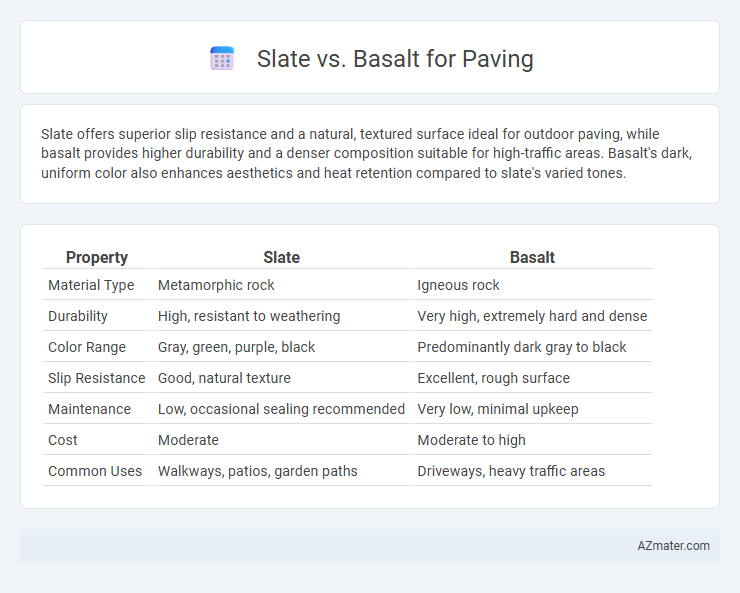Slate offers superior slip resistance and a natural, textured surface ideal for outdoor paving, while basalt provides higher durability and a denser composition suitable for high-traffic areas. Basalt's dark, uniform color also enhances aesthetics and heat retention compared to slate's varied tones.
Table of Comparison
| Property | Slate | Basalt |
|---|---|---|
| Material Type | Metamorphic rock | Igneous rock |
| Durability | High, resistant to weathering | Very high, extremely hard and dense |
| Color Range | Gray, green, purple, black | Predominantly dark gray to black |
| Slip Resistance | Good, natural texture | Excellent, rough surface |
| Maintenance | Low, occasional sealing recommended | Very low, minimal upkeep |
| Cost | Moderate | Moderate to high |
| Common Uses | Walkways, patios, garden paths | Driveways, heavy traffic areas |
Introduction to Slate and Basalt as Paving Materials
Slate and basalt are popular natural stones used in paving due to their durability and aesthetic appeal. Slate is a fine-grained metamorphic rock known for its smooth texture, range of colors from gray to green, and natural cleft surface, making it slip-resistant and visually attractive. Basalt, an igneous volcanic rock, offers exceptional hardness and weather resistance with a dense, dark appearance often preferred for heavy-traffic areas and modern design schemes.
Geological Origins: How Slate and Basalt Are Formed
Slate forms through the low-grade metamorphism of shale, resulting in fine-grained, foliated rock with excellent cleavage properties ideal for paving. Basalt originates from rapidly cooled lava flows of mafic magma, creating a dense, fine-grained igneous rock known for its durability and dark color. The contrasting geological origins of slate and basalt directly influence their texture, strength, and suitability for various paving applications.
Physical Characteristics: Texture and Appearance
Slate exhibits a fine-grained, foliated texture with a smooth-to-ridged surface, often showcasing deep, rich colors like dark gray, green, or purple that enhance outdoor paving aesthetics. Basalt features a dense, fine-grained, and typically more uniform texture with a naturally rough, matte finish, predominantly in dark charcoal to black shades, offering excellent slip resistance for paving applications. The distinct layering in slate provides varied visual interest, while basalt's consistent coloration and texture lend a sleek, modern look ideal for contemporary designs.
Durability and Strength Comparison
Slate offers excellent durability with a natural resistance to cracking and warping, making it ideal for high-traffic paving areas. Basalt, composed of dense volcanic rock, provides superior strength and hardness, outperforming slate in impact resistance and wear over time. Both materials exhibit low porosity, ensuring longevity and minimal maintenance in outdoor paving applications.
Slip Resistance and Weather Performance
Slate offers superior slip resistance due to its natural cleft texture, making it ideal for outdoor paving in wet conditions. Basalt provides exceptional weather performance, with high durability and resistance to freezing and thawing cycles. Both materials maintain structural integrity, but slate's textured surface enhances safety on slippery surfaces.
Installation Process and Maintenance Needs
Slate paving requires careful installation due to its natural cleft surface, demanding skilled labor to ensure proper alignment and spacing to prevent cracking; its maintenance involves regular sealing to preserve color and resistance to stains. Basalt paving offers easier installation with uniform thickness and smooth texture, allowing for quicker setting and less risk of breakage during placement; maintenance is minimal, typically requiring only periodic cleaning to maintain its durability and natural appearance. Both materials are durable, but slate's textured surface needs more attention during installation and upkeep compared to basalt's consistent and low-maintenance nature.
Suitability for Outdoor and Indoor Paving
Slate offers excellent durability and slip resistance, making it highly suitable for both indoor and outdoor paving, especially in areas with moderate foot traffic and weather exposure. Basalt, being denser and more weather-resistant, excels in outdoor applications, particularly in harsh climates due to its hardness and low porosity, ensuring longevity under heavy use. For indoor settings, slate provides aesthetic versatility with its natural cleft surface, while basalt's uniform texture suits modern, minimalist designs.
Cost Analysis: Slate vs Basalt Pricing
Slate typically ranges from $10 to $30 per square foot, offering a mid-range cost option for paving that balances durability with aesthetic appeal. Basalt, often priced between $15 and $40 per square foot, tends to be more expensive due to its dense, durable nature and resistance to weathering. Selecting between slate and basalt for paving depends on budget constraints and desired longevity, with basalt providing a higher initial investment but potentially lower maintenance costs over time.
Environmental Impact and Sustainability
Slate and basalt are both natural stones that offer eco-friendly paving options, with slate being more abundant and generally quarried with less environmental disruption. Basalt exhibits higher durability and weather resistance, reducing the need for frequent replacement and minimizing long-term waste. The carbon footprint of basalt may be higher due to energy-intensive extraction and processing, while slate's lower density often results in reduced transportation emissions.
Choosing the Right Stone: Key Considerations
Choosing the right stone for paving involves evaluating durability, slip resistance, and aesthetic appeal between slate and basalt. Slate offers a naturally textured surface with excellent slip resistance and a variety of earthy tones, making it ideal for garden paths and patios, while basalt provides superior strength, density, and a sleek, dark finish suited for heavy-traffic areas. Considering factors such as climate resilience, maintenance requirements, and installation costs ensures the selected stone aligns perfectly with the functional and design needs of the paving project.

Infographic: Slate vs Basalt for Paving
 azmater.com
azmater.com